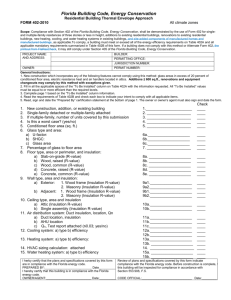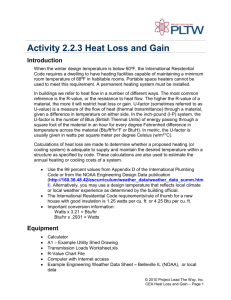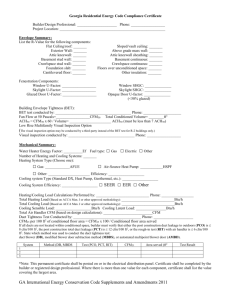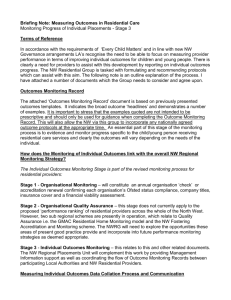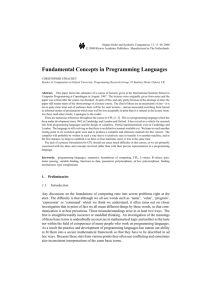Residential Bldg Energy Conservation for Additions Alternative
advertisement
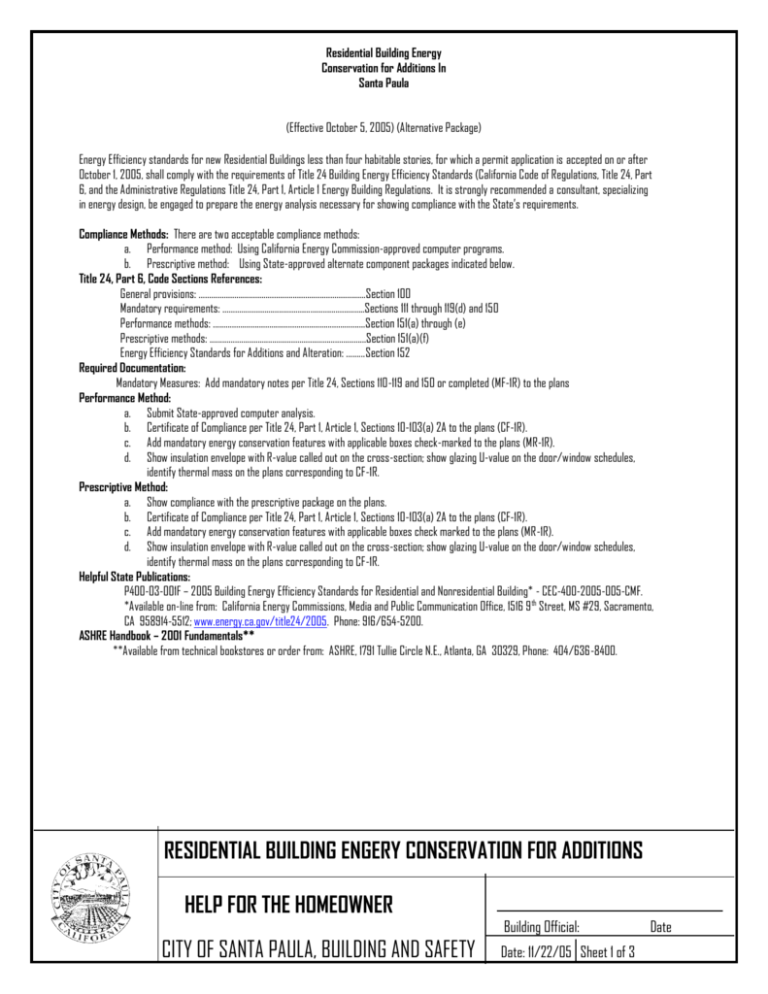
Residential Building Energy Conservation for Additions In Santa Paula (Effective October 5, 2005) (Alternative Package) Energy Efficiency standards for new Residential Buildings less than four habitable stories, for which a permit application is accepted on or after October 1, 2005, shall comply with the requirements of Title 24 Building Energy Efficiency Standards (California Code of Regulations, Title 24, Part 6, and the Administrative Regulations Title 24, Part 1, Article 1 Energy Building Regulations. It is strongly recommended a consultant, specializing in energy design, be engaged to prepare the energy analysis necessary for showing compliance with the State’s requirements. Compliance Methods: There are two acceptable compliance methods: a. Performance method: Using California Energy Commission-approved computer programs. b. Prescriptive method: Using State-approved alternate component packages indicated below. Title 24, Part 6, Code Sections References: General provisions: ……………………………………………………………………..Section 100 Mandatory requirements: …………………………………………………………..Sections 111 through 119(d) and 150 Performance methods: ……………………………………………………………….Section 151(a) through (e) Prescriptive methods: …………………………………………………………………Section 151(a)(f) Energy Efficiency Standards for Additions and Alteration: ……...Section 152 Required Documentation: Mandatory Measures: Add mandatory notes per Title 24, Sections 110-119 and 150 or completed (MF-1R) to the plans Performance Method: a. Submit State-approved computer analysis. b. Certificate of Compliance per Title 24, Part 1, Article 1, Sections 10-103(a) 2A to the plans (CF-1R). c. Add mandatory energy conservation features with applicable boxes check-marked to the plans (MR-1R). d. Show insulation envelope with R-value called out on the cross-section; show glazing U-value on the door/window schedules, identify thermal mass on the plans corresponding to CF-1R. Prescriptive Method: a. Show compliance with the prescriptive package on the plans. b. Certificate of Compliance per Title 24, Part 1, Article 1, Sections 10-103(a) 2A to the plans (CF-1R). c. Add mandatory energy conservation features with applicable boxes check marked to the plans (MR-1R). d. Show insulation envelope with R-value called out on the cross-section; show glazing U-value on the door/window schedules, identify thermal mass on the plans corresponding to CF-1R. Helpful State Publications: P400-03-001F – 2005 Building Energy Efficiency Standards for Residential and Nonresidential Building* - CEC-400-2005-005-CMF. *Available on-line from: California Energy Commissions, Media and Public Communication Office, 1516 9 th Street, MS #29, Sacramento, CA 958914-5512; www.energy.ca.gov/title24/2005. Phone: 916/654-5200. ASHRE Handbook – 2001 Fundamentals** **Available from technical bookstores or order from: ASHRE, 1791 Tullie Circle N.E., Atlanta, GA 30329, Phone: 404/636-8400. RESIDENTIAL BUILDING ENGERY CONSERVATION FOR ADDITIONS HELP FOR THE HOMEOWNER Building Official: CITY OF SANTA PAULA, BUILDING AND SAFETY Date: 11/22/05 Sheet 1 of 3 Date Residential Building Energy Conservation for Additions In Santa Paula Basic Component Compliance Packages for New Residential Building Additions Floor Area Component Building Envelope Insulation Minimums1 Ceiling Wood-frame walls “Heavy” mass walls “Light mass” walls Below-grade walls Slab Floor, Perimeter Raised floors Concrete raised floors Radiant Barrier9 Fenestration Maximum U-Factor2 Maximum Solar Heat Gain Coefficient (SHGC)2 Maximum Total Area Maximum West Facing Thermal Mass4 Space Heating System5 Electric Resistance Allowed If Gas, AFUE= If Heat Pump: HSPF6= Space Cooling System10 SEER= If split system, refrigerant change measurement or thermostatic expansion valve* Ducts* Duct Sealing Duct Installation Domestic Water Heating Type System must meet budget, see sections 151 (b) or 151 (f) 8 <100 ft2 Climate Zone 9 <1000 ft2 Climate Zone 9 >1000 ft2 Climate Zone 9 R-30 R-13 (R-2.44) NA RO NR R-19 RO REQ R-30 R-13 (R-2.44) NA RO NR R-19 RO REQ R-30 R-13 (R-2.44) NA RO NR R-19 RO REQ 0.38 0.38 0.38 .31 .31 .31 <50 sft 20% + 5% 20% 5% NR NR NR NO MIN MIN NO MIN MIN NO MIN MIN MIN REQ* MIN REQ* MIN REQ* NR8 R-6 NR8 R-6 NR8 R-6 50 Gallons or Meet Budget 50 Gallons or Meet Budget 50 Gallons or Meet Budget Legend: NR = Not Required; NA = Not Applicable; MIN = Minimum Rated Capacity * Duct sealing, thermostatic expansion valve and refrigerant charge shall be field verified by HERS (Home Energy Rating System) rater. (see Footnotes on the next page.) RESIDENTIAL BUILDING ENGERY CONSERVATION FOR ADDITIONS HELP FOR THE HOMEOWNER Building Official: CITY OF SANTA PAULA, BUILDING AND SAFETY Date: 11/22/05 Sheet 2 of 3 Date Residential Building Energy Conservation for Additions In Santa Paula Footnotes to Prescriptive Packages (for Code Reference, see Publication P400-03-001F) 1 The heavy mass wall R-value in parentheses is the minimum R-value for the entire wall assembly if the wall weight exceeds 40 pounds per square foot. The light mass wall R-value in brackets is the minimum R-Value for the entire assembly if the heat capacity of the wall meets or exceeds the result of multiplying the bracketed minimum R-value by 0.65. Any insulation installed on heavy or light mass walls must be integral with, or installed on the outside of the exterior mass. The inside surface of the thermal mass, including plaster or gypsum board in direct contact with the masonry wall, shall be exposed to the room air. The exterior wall used to meet the R-value in parentheses cannot also be used to meet the thermal mass requirement. 2 The installed fenestration products shall meet the requirements of Section 151 (f) 3. Dual-glazed greenhouse windows and dual glazed skylights are assumed to meet the applicable U-factor requirement. 3 The installed fenestration products shall meet the requirements of Section 151 (f) 4. 4 If the package requires thermal mass, the thermal mass shall meet the requirements of Section 151 (f) 5. 5 Automatic setback thermostats shall be installed in conjunction with all space-heating systems in accordance with Section 151 (f) 9. 6 HSPF means “heating seasonal performance factor.” 7 Not Applicable. 8 As an alternate under Package D in climate zone 9, glazing with a maximum 0.38 U-factor and maximum 0.31 SHGC may be substituted for duct sealing and either refrigerant charge measurement or a thermostatic expansion valve. All other requirements of Package D must be met. 9 The radian barrier requirement applies only to the roof area of the addition. It is not necessary to retrofit a radiant barrier in the existing attic. 10 As an alternate to glazing with a maximum 0.38 U-factor and maximum 0.31 SHGC or HERS rater duct verification. The high efficiency space cooling and heating systems may be installed with 0.67 U-factor and .40 solar heat gain. SEER-14 and SEER-12 with either TXV or refrigerant charge measurement, plus either 0.92 AFUE with R-4 duct insulation or 0.82 AFUE with R-8 duct insulation. RESIDENTIAL BUILDING ENGERY CONSERVATION FOR ADDITIONS HELP FOR THE HOMEOWNER Building Official: CITY OF SANTA PAULA, BUILDING AND SAFETY Date: 11/22/05 Sheet 3 of 3 Date


